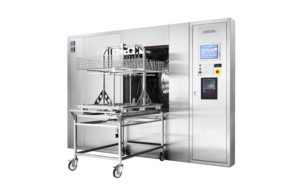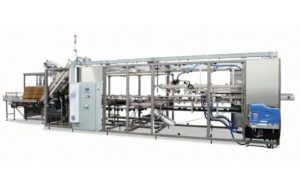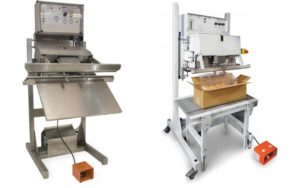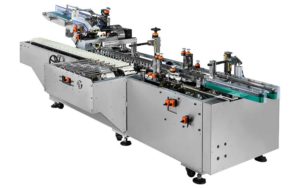The videos below are examples of the Labeling Machinery Frain Carries
Shrink Sleever Videos
Front & Back Wrap Videos
Pressure Sensitive Wrap Videos
Pressure Sensitive Spot Videos
Pressure Sensitive Print & Apply Videos
Roll Through Glue Wrap Videos
Learn more about Labeling Machinery
- Labeling Solutions White Paper
- Label Issues
- Cold Glue Labelers White Paper
- Poka Yoke Label Guages
- Pressure-Sensitive Labeling Machine White Paper
- Shrink Banders and Sleevers
It is hard to think of a product without at least one label. Labels have many purposes and come in many materials including paper, plastic and foil. They may be die cut in complex shapes or may be butt cut squares or rectangles. They may be sheet, roll or web fed. They may be applied with hot or cold glue or with pre-applied pressure sensitive adhesive.
The variety is seemingly endless. This paper will focus on automated pressure sensitive (PS) labeling equipment.
Pressure sensitive labels are supplied on a backing web. The web is coated with a releasing finish and the labels are coated with an adhesive. They are typically supplied on rolls though fan-folded labels are also used occasionally. Typically, even if square or rectangular, they are diecut on the web with a 1/16” gap left between labels.
The basic principle of pressure operation is easy to understand. The web is pulled across a peeler plate which bends it about 180 degrees. As the web is pulled backwards, the label continues forward, releasing from the web and either going directly onto the product or staging onto an intermediate applicator which applies the label to the product.
GET THE FULL WHITE PAPER HERE: DOWNLOAD WHITE PAPER PDF
When problems occur with a labeling machine, some of us have a tendency to blame the machine and start adjusting. True, there are often machine based issues. They get out of adjustment, wear or even break. But the materials can cause a lot of issues too. This month I want to talk about some common problems that can occur with pressure sensitive labeling equipment.
Web breakage
In most case, labels are supplied on a backing web of coated paper. This paper needs good tensile strength which allows it to be pulled through the labeler. Strong as it is, any damage such as a slight nick in the edge or an excessively deep diecut will rob it of almost all its strength.
Nicks can occur during handling of the label roll or while in the labeling machine. As the label web passes over the various guide and nip rollers any misalignment of the rollers will move the web out of its desired path. Some operators and even mechanics will try to use guide collars on the rolls to force the web to the desired position. This seldom works as expected. It usually drags along the web edge causing nicks and weak spots.
Another cause of web breakage is improper die cutting. At the converter a knife must cut completely through the label without cutting into the web. If it cuts too deeply, into the web, it will cause a weak spot. The depth of cut may be checked with a felt tip marker. Place a section of web with not labels on a sheet of white paper. Rub the marker over the suspect areas. If it is cut, the ink will bleed through to the paper below.
Adhesives
Label adhesives It must be carefully matched to the product. There are several hundred types available and one sizes does not fit all. An adhesive that is fine for room temperature glass may not adhere at all to a plastic bottle at 40 degrees.
If a label/container combination has been working fine but begins causing problems, check to see that the supplier has not changed adhesives.
Changes to the container can cause similar issues. In one instance a label had been running well for more than a year when it suddenly started wrinkling on application. After considerable head-scratching it turned out that the converter had changed from flame treatment of the bottles to plasma treatment. This prevented the adhesive from achieving proper initial tack.
Excessive adhesive and/or rolls that are too tightly wound can cause the adhesive to squeeze out from under the label. When this happens the label face can stick to the back of the web, the web itself can stick together, glue can accumulate in the labeler rollers or all of the above. If the labels have the right amount of adhesive but are too tightly wound, all of the above can occur plus there may not be enough adhesive left on the label to properly adhere to the container.
These are only a few of the labeling machine issues that can drive you nuts on the line. My main point today is don’t immediately assume the machine is at fault and start adjusting. Before touching anything, figure out what the problem really is.
Pressure sensitive labels are supplied in rolls, on plastic or paper backing strips with the adhesive already applied. Pressure sensitive label applicators are simple to operate and maintain, can run at fairly high speeds (up to 750ppm or more) and do not require cleaning of excess adhesive.
The downside of pressure sensitive labeling equipment is that on the fly roll splicing is difficult and the labeling equipment need to be shut down frequently, as often as every 30 minutes in some cases for roll replacement. Another issue is that the backing web needs to be disposed of. The backing web adds cost to pressure sensitive labels.
Glue labeling equipment apply cold glue or hot melt glue to the label or the package, most often a bottle or can, at the point of label application. Then they put the label on the package.
Glue labels can be supplied in continuous rolls or can be supplied as individual, precut labels. When supplied on rolls, the labels will almost always be square or rectangular. This allows them to be cut off with a straight blade. Some labelers can diecut a shaped label but this adds complexity to the machine. Another issue is that the waste material from the diecut needs to be removed from the labeler. Even under the best operation this will never be perfect. Accumulations of waste can cause jams or other problems.
Another option is to use labels that are cut at the converter and supplied in stacks. Precut labels are often square or rectangular. For cans, they are almost always rectangular. Precut labels can also be diecut into virtually any shape by the converter.
As with anything else in packaging, there are advantages and disadvantages to both precut and roll fed labeling.
READ THE REST OF THE WHITE PAPER HERE: DOWNLOAD PDF
I’ve spent a lot of time watching labeler machine changeovers. One time sink I’ve noticed typically occurs after the changeover is complete. Or at least after the mechanic thinks it is complete. They are all ready to go and someone, often quality, says “Hey, Wait a minute. That label is out of position. It is too high.” Or too low. Or skewed, or off center or something else.
So they lose time re-adjusting the label position. Worse, they may lose even more time discussing, sometimes vigorously, whether the label is REALLY out of position. It’s an argument the mechanic can never win, But they still lose the time trying. In the end, they readjust
An issue with label position is that some plants have no good specification where it goes. Even where the specification exists, there may be no good way of verifying compliance. At one of my clients the maintenance manager got tired of this constant battle.
He came up with a simple idea. So simple that I had never seen it anywhere else. Actually so simple that it made me feel bad for not having thought of it. (The man was a genius). He was also a good machinist. He went to his shop, chucked a piece of plastic rod in the lathe and bored it out so the labeled bottle would drop in. He then milled a window in the side so the label could be seen.
Anyone can see at a glance whether the label is in position or not. No more disagreement. The mechanic knows, when setting the labeling machine, that the label is correct. If not, they adjust it. Everyone else can see that the label is in position so no more discussion.
The line restarts and everybody wins. This is an example of the Japanese concept called Poka-Yoke. Loosely translated, Poka-Yoke means mistake proofing. It means designing a process or part so that it is impossible to do improperly. This book, from Productivity Press, is filled with great, simple examples of mistake proofing.
Whether you need a single machine or a complete line, Frain will Poka-Yoke your next project. You just can’t make a mistake with Frain. Rent, buy or lease Frain has what you need. More importantly, Frain makes it work.
Pressure sensitive labels, sometimes called self-adhesive, auto-adhesive or just PS labels, come with the adhesive (glue) pre-applied. In order to prevent the labels from sticking to each other and to allow feeding, they are supplied on a coated paper or plastic backing sheet. A pressure-sensitive labeling machine does have some nice advantages.
There are a number of advantages to PS labels:
- Applicating machinery is relatively simple compared to hot and cold glue labels.
- The labels can be made of virtually any material
- Labels can be die cut to any shape, embossed, provided with windows and other features to add function and pizazz to the product.
- Leaflet labels, combining multiple foldout pages in a single label can be used
- Speeds can range from a few cpm in a manual operation to 500 or more cpm on a high-speed line.
- There is no adhesive mess to clean up.
- There is no additional adhesive to buy.
- There is much less possibility of a label mixup as with cut labels.
There are some downsides too:
- Labels are more expensive
- Routine stoppages are required for roll replacement
- The backing web makes the labels effectively twice as thick reducing the number that can be carried on a roll. This increases the replenishment frequency.
- Splicing a new label roll to the runout roll is difficult to automate requiring stopping the labeler for splicing a new roll.
- The backing web material is waste that must be disposed of
READ THE REST OF THIS WHITE PAPER HERE: DOWNLOAD WHITE PAPER PDF
Shrink sleeves have many uses in packaging. They can be used to label and identify, to group multipacks like a shampoo/conditioner offer, protect fragile glass containers, and make a blah glass container look like fancy ceramic. They can also be used to provide a security or tamper evident seal and this is their most common use.
Most shrink sleeves are made from PVC film but other materials are sometimes used. They are commonly made by folding flat film into a seal and welding a longitudinal seam. Forming from flat film allows access to the full film for printing. Some sleeve material is extruded as a tube but this is usually not printed. As virtually all film is printed, even if just a “Sealed for your protection” message extruded sleeve material will be ignored in this paper. In any event, application is the same for both types of film.
Film is normally supplied on continuous reels or rolls for machine application. In some applications precut sleeves are used. These are applied manually and are outside of the scope of this paper.
Two types of printing are commonly used with sleeves: continuous and registered. While the films are the same, registered film requires an application machine capable of registration.
READ THE REST OF THIS WHITE PAPER: DOWNLOAD PDF
Some of the Manufacturers We Carry





Contact Your Engineer
Discuss your application directly with our qualified engineers.



